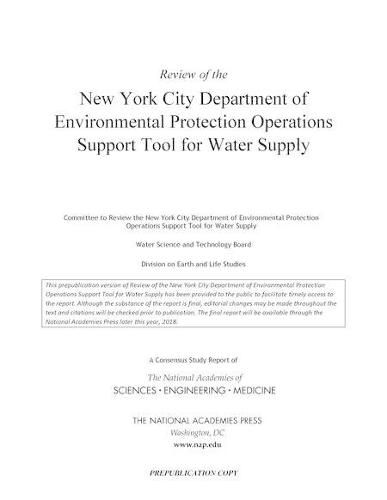Readings Newsletter
Become a Readings Member to make your shopping experience even easier.
Sign in or sign up for free!
You’re not far away from qualifying for FREE standard shipping within Australia
You’ve qualified for FREE standard shipping within Australia
The cart is loading…






New York City’s water supply system is one of the oldest, largest, and most complex in the nation. It delivers more than 1.1 billion gallons of water each day from three upstate watersheds (Croton, Catskill, and Delaware) to meet the needs of more than eight million people in the City, one million people in Westchester, Putnam, Orange, and Ulster counties, and millions of commuters and tourists who visit the City throughout the year. The Catskill and Delaware portions, which make up about 90 percent of the supply, receive no filtration or treatment other than disinfection, except for rare instances of high turbidity when a coagulant is added to increase deposition of suspended solids. The remaining 10 percent of the supply comes from the Croton watershed and receives treatment via filtration.
The drinking water supply is managed by the Bureau of Water Supply within the New York City Department of Environmental Protection (NYC DEP). To continue to avoid filtration of the Catskill/Delaware portion of the water supply, in 2007, NYC DEP reexamined its control of turbidity in the Catskill portion of the water supply, including both structural improvements to the system and operational changes. The Operations Support Tool (OST) was developed as part of these efforts. OST couples models of reservoir operations and water quality; it uses real-time data on streamflow, snow pack, water quality, reservoir levels, diversions, and releases; and it incorporates streamflow forecasts?all in order to predict future reservoir levels, water delivery to customers, and water quality within the system. These predictions inform the system operators, who then make decisions based on the most current data and forecasts.
This report reviews the use of OST in current and future reservoir operations. It considers potential ways in which the City can more effectively use OST, makes recommendations for additional performance measures, and reviews the potential effects of climate change on the City’s water supply to help identify and enhance understanding of areas of potential future concern with regard to the use of OST.
$9.00 standard shipping within Australia
FREE standard shipping within Australia for orders over $100.00
Express & International shipping calculated at checkout
New York City’s water supply system is one of the oldest, largest, and most complex in the nation. It delivers more than 1.1 billion gallons of water each day from three upstate watersheds (Croton, Catskill, and Delaware) to meet the needs of more than eight million people in the City, one million people in Westchester, Putnam, Orange, and Ulster counties, and millions of commuters and tourists who visit the City throughout the year. The Catskill and Delaware portions, which make up about 90 percent of the supply, receive no filtration or treatment other than disinfection, except for rare instances of high turbidity when a coagulant is added to increase deposition of suspended solids. The remaining 10 percent of the supply comes from the Croton watershed and receives treatment via filtration.
The drinking water supply is managed by the Bureau of Water Supply within the New York City Department of Environmental Protection (NYC DEP). To continue to avoid filtration of the Catskill/Delaware portion of the water supply, in 2007, NYC DEP reexamined its control of turbidity in the Catskill portion of the water supply, including both structural improvements to the system and operational changes. The Operations Support Tool (OST) was developed as part of these efforts. OST couples models of reservoir operations and water quality; it uses real-time data on streamflow, snow pack, water quality, reservoir levels, diversions, and releases; and it incorporates streamflow forecasts?all in order to predict future reservoir levels, water delivery to customers, and water quality within the system. These predictions inform the system operators, who then make decisions based on the most current data and forecasts.
This report reviews the use of OST in current and future reservoir operations. It considers potential ways in which the City can more effectively use OST, makes recommendations for additional performance measures, and reviews the potential effects of climate change on the City’s water supply to help identify and enhance understanding of areas of potential future concern with regard to the use of OST.